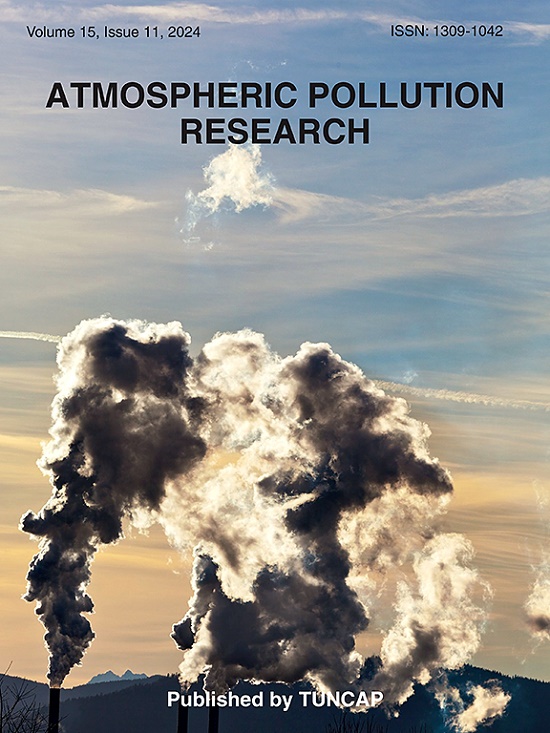为乌干达中南部城市和农村环境PM2.5监测校准低成本传感器数据
IF 3.5
3区 环境科学与生态学
Q2 ENVIRONMENTAL SCIENCES
引用次数: 0
摘要
空气污染是造成全球疾病负担的一个主要风险因素。撒哈拉以南非洲(SSA)的数据有限。本研究解决了乌干达中南部空气质量监测方面的重大数据缺口。我们利用拉凯地区农村地区以及马萨卡和坎帕拉等城市的近参考级监测仪和27个低成本空气质量监测仪网络,开发了一个适合当地的环境PM2.5浓度校准模型。利用所有低成本监测仪的校准数据,我们研究了环境PM2.5浓度的时空趋势。与原始数据的RMSE为20.37 μg/m3,偏差为15.96 μg/m3相比,校正模型的R2为0.92,均方根误差(RMSE)为3.83 μg/m3,偏差为- 0.39 μg/m3,校正模型对相对湿度进行了调整。干湿季PM2.5平均浓度农村为22.1 μg/m3、12.7 μg/m3,城市为37.7 μg/m3、23.2 μg/m3。我们观察了日变化,PM2.5水平在清晨(早上6点至9点)和傍晚(下午6点至10点)达到峰值,与交通高峰时间相关。低成本传感器可以加强乌干达中南部等缺乏空气污染数据的地区的空气质量研究。因地制宜的校准可以提高环境PM2.5浓度的测量精度。本文章由计算机程序翻译,如有差异,请以英文原文为准。
Calibration of low-cost sensor data for ambient PM2.5 monitoring across urban and rural settings in South Central Uganda
Air pollution is a leading risk factor for the global burden of disease. There are limited data from Sub-Saharan Africa (SSA). This study addresses significant data gaps in air quality monitoring in South-Central Uganda. Using a near-reference grade monitor and a network of 27 low-cost air quality monitors in the rural Rakai region and urban cities of Masaka and Kampala, we developed a locally tailored calibration model for ambient PM2.5 concentrations. Using calibrated data across all low-cost monitors, we then examined spatiotemporal trends in ambient PM2.5 concentrations. The calibration model, which adjusts for relative humidity, demonstrated robust performance with an R2 of 0.92, a root mean squared error (RMSE) of 3.83 μg/m3 and bias of −0.39 μg/m3 compared to an RMSE of 20.37 μg/m3 and bias of 15.96 μg/m3 with the raw data. Mean PM2.5 concentrations during the dry and wet seasons were 22.1 μg/m3 and 12.7 μg/m3 in rural areas, and 37.7 μg/m3 and 23.2 μg/m3 in urban areas, respectively. We observed diurnal variations, with PM2.5 levels peaking in the early morning (6 a.m.–9 a.m.) and late evening (6 p.m.–10 p.m.), correlating with peak traffic hours. Low-cost sensors can enhance air quality research in regions like South-Central Uganda that lack air pollution data. Calibration tailored to local conditions can improve measurement accuracy of ambient PM2.5 concentrations.
求助全文
通过发布文献求助,成功后即可免费获取论文全文。
去求助
来源期刊

Atmospheric Pollution Research
ENVIRONMENTAL SCIENCES-
CiteScore
8.30
自引率
6.70%
发文量
256
审稿时长
36 days
期刊介绍:
Atmospheric Pollution Research (APR) is an international journal designed for the publication of articles on air pollution. Papers should present novel experimental results, theory and modeling of air pollution on local, regional, or global scales. Areas covered are research on inorganic, organic, and persistent organic air pollutants, air quality monitoring, air quality management, atmospheric dispersion and transport, air-surface (soil, water, and vegetation) exchange of pollutants, dry and wet deposition, indoor air quality, exposure assessment, health effects, satellite measurements, natural emissions, atmospheric chemistry, greenhouse gases, and effects on climate change.
 求助内容:
求助内容: 应助结果提醒方式:
应助结果提醒方式:


